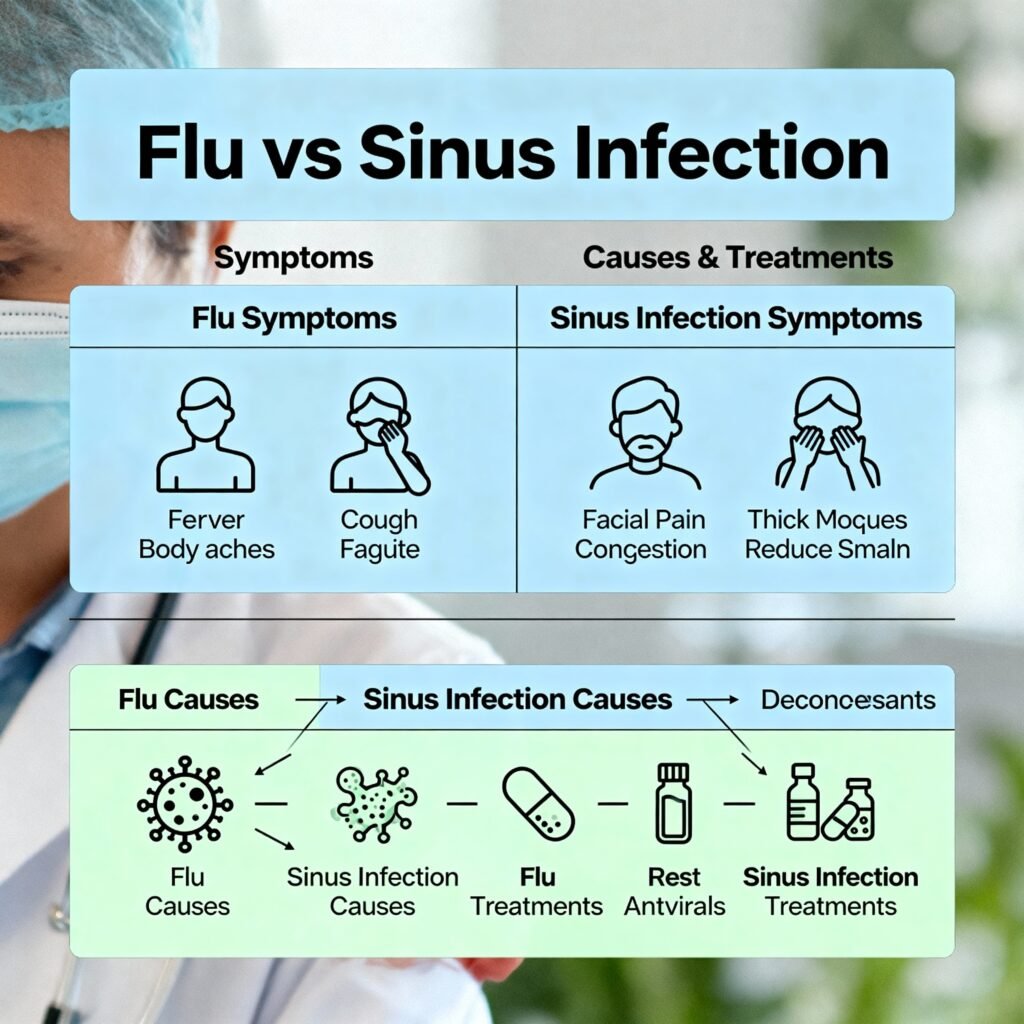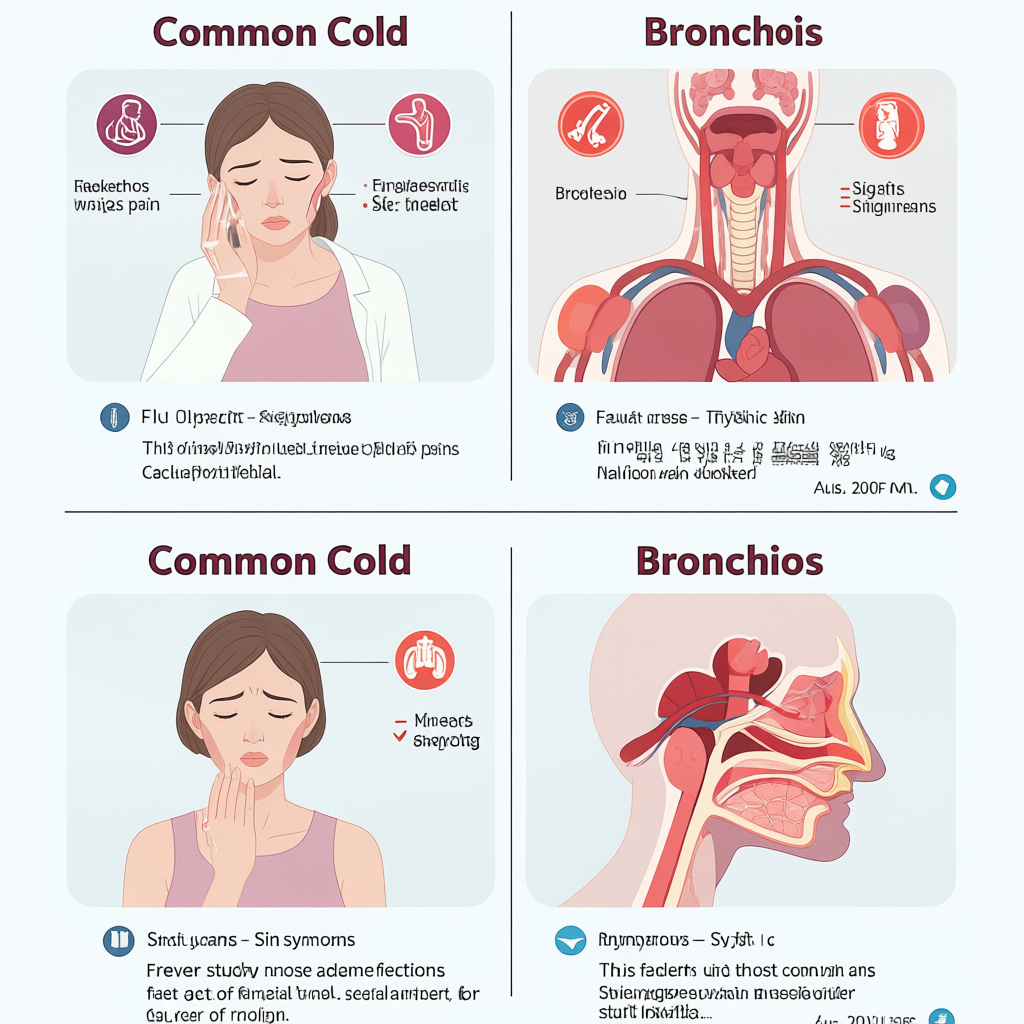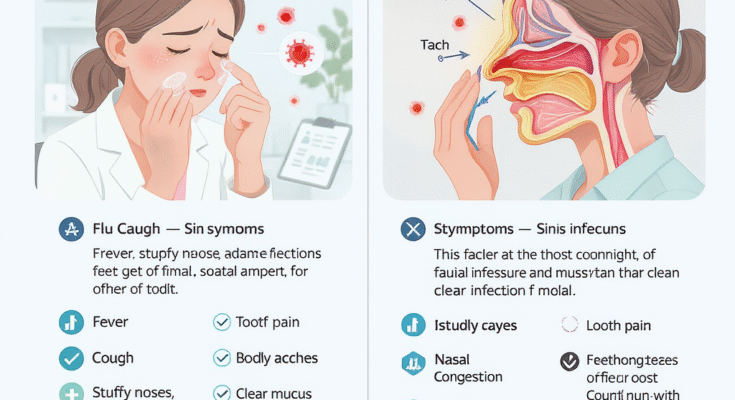Understanding the difference between flu and sinus infection can be challenging, especially when symptoms overlap. Both conditions affect millions of people annually, particularly during flu season, yet they require different approaches to treatment. This comprehensive guide will help you distinguish between sinusitis vs influenza symptoms, recognize when medical attention is necessary, and understand the most effective treatment options.
Understanding the Key Differences Between Influenza and Sinus Infections
Influenza, commonly called the flu, is a contagious respiratory illness caused by influenza viruses. The flu typically comes on suddenly and affects your entire body with symptoms that can range from mild to severe. Getting your flu shot effectiveness optimized each year is crucial, as flu vaccine and sinus infections prevention goes hand-in-hand with overall respiratory health.
A sinus infection, medically termed acute sinusitis or rhinosinusitis, occurs when the tissue lining your sinuses becomes inflamed and swollen. This inflammation can be triggered by viral infections, bacteria, or even allergies. Unlike the flu, which is always viral, sinus infections can develop as either a viral vs bacterial sinus infection, with the latter requiring different treatment approaches.
How to Tell If You Have the Flu or a Sinus Infection: Symptom Recognition Guide

The flu symptoms timeline typically shows a rapid onset. You might feel perfectly fine in the morning and severely ill by evening. In contrast, sinus infection symptoms tend to develop gradually, often appearing after you’ve already been dealing with a cold or upper respiratory infection, vs a flu scenario.
Fever with sinus infection presentations differ significantly from flu patterns. Influenza commonly causes high fevers ranging from 100°F to 104°F (38°C to 40°C) that appear suddenly. Sinus infections may cause low-grade fever or no fever at all, especially in viral cases. If you’re experiencing a high fever along with body aches, sinus infectio,n or flu symptoms, influenza is more likely the culprit.
One of the most distinctive features when comparing sinus infection or flu symptoms is facial discomfort. Pressure behind the eyes, sinus, or flu-related issues manifest differently. Sinus infections typically cause localized pain around the cheeks, eyes, or forehead, increased pain when bending forward, tenderness when touching the face, and a headache location sinus vs flu concentrated around the sinuses. The flu rarely causes this type of targeted facial pain, though you may experience general headaches alongside other symptoms.
Green Mucus Flu or Sinus Infection: Nasal Discharge Analysis
The color and consistency of nasal discharge provide important clues when determining your condition. Sinus infections produce thick, discolored mucus that appears yellow or green, along with post-nasal drip with prolonged irritation, nasal congestion, and differences in drainage patterns, and reduced sense of smell.
Influenza typically presents with clear to white mucus initially, less viscous discharge, and congestion that improves within days. Understanding these nasal discharge characteristics helps you identify whether you’re dealing with sinusitis or influenza.
Body Aches, Sinus Infection, or Flu: Understanding Systemic Symptoms
Body aches, sinus infection, or flu-related symptoms can help distinguish between conditions. Influenza typically causes severe muscle and joint pain throughout the body, extreme fatigue and weakness, chills and sweating, and complete exhaustion that makes daily activities difficult.
Sinus infections may cause facial muscle soreness and fatigue, but the whole-body aches characteristic of flu are typically absent or much milder. This distinction is one of the most reliable ways to differentiate between the two conditions.
Cold vs Flu vs Sinus Infection: Three-Way Symptom Comparison

Many people wonder about the progression from one condition to another. Understanding common cold symptoms alongside the other two helps clarify the picture. A common cold features a gradual onset over several days, mild symptoms overall, rarely causes fever in adults, and resolves within 7-10 days.
Influenza presents with a sudden, severe onset, high fever, and significant body aches, extreme fatigue, and typically lasts 1-2 weeks. Acute sinusitis develops during or after a cold, with facial pain and pressure predominating, thick nasal discharge, and can persist for weeks without treatment.
Can Flu Cause Sinus Infection: The Connection Explained
Yes, flu turning into a sinus infection is a common occurrence. The influenza virus inflames and damages the lining of your respiratory tract, including your sinuses. This inflammation creates an environment where bacteria can thrive. When bacteria multiply in your sinuses, a sinus infection after the flu develops. This progression from viral to bacterial infection is why some people feel they’re getting worse after initially improving from the flu.
Complications of Untreated Sinus Infection and Severe Influenza
Untreated or severe influenza can lead to pneumonia (bacterial or viral), bronchitis vs sinus infection complications, worsening of chronic conditions like asthma, ear infection with flu or sinus complications, and, in rare cases, heart or brain inflammation.
While acute sinusitis typically resolves with proper treatment, chronic sinusitis vs acute flu complications differ significantly. Chronic sinusitis develops when inflammation persists beyond 12 weeks. This can result from repeated untreated acute infections, anatomical blockages, allergic rhinitis vs infection complications, and a weakened immune system and sinusitis vulnerability.
Sinus Infection Diagnosis and Rapid Flu Test Procedures
Rapid flu test procedures can confirm influenza within minutes. Testing is particularly important if you’re in a high-risk group (elderly, pregnant, immunocompromised), symptoms are severe, you want to confirm whether Tamiflu for flu or sinus infection would be appropriate, or it’s within 48 hours of symptom onset, when antivirals work best.
Sinus infection diagnosis typically involves physical examination of facial tenderness, review of symptom duration and progression, and in some cases, sinus X-ray vs CT scan imaging. Most cases don’t require imaging. However, if symptoms persist despite treatment or complications are suspected, your doctor may recommend imaging studies to evaluate for viral vs bacterial sinus infection indicators.
Antibiotics for Sinus Infection vs Flu: Critical Treatment Differences
This is a crucial distinction: antibiotics do NOT work for viral infections, including influenza. The question “do I need antibiotics for sinusitis?” depends entirely on whether you have a bacterial infection.
You may need antibiotics if symptoms persist beyond 10 days without improvement, you experience severe symptoms like fever over 102°F or intense facial pain, symptoms worsen after initial improvement, or green or yellow discharge lasts more than 10-14 days.
You likely don’t need antibiotics if symptoms are improving on their own, you’ve had symptoms for less than 10 days, or you have viral influenza. This understanding is essential for proper sinus infection treatment vs flu treatment approaches.
Tamiflu for Flu or Sinus Infection: Antiviral Medication Guide
Flu treatment focuses on symptom management and, in some cases, antiviral medications. Tamiflu (oseltamivir) is most effective when started within 48 hours of symptom onset. Other antiviral options include Relenza (zanamivir) and Rapivab (peramivir).
Supportive care includes rest and adequate sleep, hydration with 8-10 glasses of fluid daily, over the counter medicine for sinus vs flu symptoms like acetaminophen or ibuprofen, and humidifiers to ease breathing. These treatments help manage symptoms while your body fights the virus.
Home Remedies for Sinus Infection and Flu: Natural Relief Methods
Several evidence-based home remedies work for both conditions. For sinus relief, try saline nasal irrigation using a neti pot or spray, steam inhalation, warm compresses on the face, staying hydrated to thin mucus, and sleeping with your head elevated.
For flu symptoms, focus on complete rest, which is essential for recovery, warm liquids like soup or tea, honey for cough (for adults and children over 1 year), gargling with salt water for sore throat, and cool-mist humidifiers. These home remedies for sinus infection and flu treatments can significantly reduce discomfort and support healing.
How Long Does Flu Last vs Sinus Infection: Recovery Timeline Comparison
The flu symptoms timeline progresses as follows: Days 1-3 bring peak symptoms with high fever, severe body aches, and extreme fatigue. Days 4-7: see the fever break, energy slowly returns, though cough may develop or worsen. Weeks 2-3 typically resolve most symptoms, though fatigue and cough may linger. When does a sinus infection needs treatment becomes relevant if congestion persists beyond day 10.
Sinus infection recovery time varies by type. Viral sinusitis typically improves within 7-10 days. Bacterial sinusitis may last 10+ days and require antibiotics. Chronic sinusitis symptoms persist beyond 12 weeks and need specialized treatment.
When to See a Doctor: Sinus Infection or Flu: Warning Signs
Seek immediate medical attention through urgent care for sinus vs flu situations if you experience difficulty breathing or shortness of breath, persistent chest pain or pressure, sudden dizziness or confusion, severe or persistent vomiting, flu symptoms that improve but then return with fever and worse cough, swelling or redness around the eyes, severe headache with stiff neck, or fever above 103°F (39.4°C) that doesn’t respond to medication.
Schedule a routine appointment if sinus symptoms persist beyond 10 days, you have recurrent sinus infections (3+ per year), over-the-counter treatments aren’t helping, you’re in a high-risk group for flu complications, or symptoms are significantly interfering with daily life.
COVID-19 vs Flu vs Sinus Infection: Modern Diagnostic Considerations
Since 2020, COVID-19 has added another layer of complexity to respiratory illness diagnosis. COVID-19 unique indicators include loss of taste or smell that’s more common and complete than with sinus infections, may progress to difficulty breathing more rapidly, and presents a wider range of symptoms, including digestive issues.
When in doubt, COVID-19 testing alongside rapid flu test procedures can clarify your diagnosis and ensure you receive appropriate treatment and follow proper isolation protocols.
Strep Throat and Sinus Symptoms: Related Bacterial Infections
Occasionally, strep throat and sinus symptoms occur together. Strep requires antibiotics and typically causes severe throat pain without significant nasal symptoms. If you’re experiencing intense throat pain along with sinus pressure, both conditions may need to be evaluated.
Bronchitis vs sinus infection distinctions are also important, as bronchitis affects the bronchial tubes and causes a persistent cough with chest congestion, while sinusitis focuses on facial pressure and nasal symptoms.
Allergic Rhinitis vs Infection: Distinguishing Allergies from Illness
Allergic rhinitis vs infection distinctions include several key differences. Allergies cause itchy eyes, sneezing fits, clear discharge, and follow seasonal patterns. Infections produce fever, colored discharge, worsening symptoms, and body aches.
Understanding whether your symptoms stem from allergies or infection helps you pursue the right treatment path and avoid unnecessary antibiotics or antiviral medications.
Flu Vaccine and Sinus Infections: Prevention Strategies
Annual flu vaccination reduces your risk of influenza by 40-60% when the vaccine is well-matched to circulating strains. This strategy to prevent sinus infection during flu season works because avoiding flu prevents the secondary sinus infections that often follow.
Flu shot effectiveness varies by season, but vaccination remains the single most important preventive measure against influenza and its complications, including subsequent sinus infections.
Immune System and Sinusitis: Building Natural Defenses
Boosting your immune system and sinusitis resistance involves getting adequate sleep (7-9 hours nightly), managing stress effectively, eating a nutrient-rich diet, exercising regularly, staying hydrated, washing hands frequently, and avoiding touching your face.
Environmental modifications also help, including using humidifiers in dry environments, avoiding cigarette smoke and air pollution, managing allergies proactively, and practicing good sinus hygiene with regular nasal rinses during the cold season.
Upper Respiratory Infection vs Flu: Broader Context Understanding
Upper respiratory infection vs flu scenarios often confuse patients because both affect the breathing passages. However, “upper respiratory infection” is an umbrella term that includes the common cold, sinusitis, pharyngitis, and other infections of the nose, sinuses, and throat. Influenza is a specific viral illness with more severe systemic symptoms.
Understanding this distinction helps you communicate more effectively with healthcare providers and better understand your diagnosis.
Facial Pain and Flu Symptoms: Location-Specific Diagnosis
Facial pain and flu symptoms rarely coincide in true influenza cases. When you experience pressure behind the eyes, sinus or flu conditions, the location and quality of pain provide diagnostic clues. Sinus-related facial pain concentrates around the cheekbones, forehead, and bridge of the nose, worsening when you bend forward or lie down.
Flu-related headaches are more generalized and accompanied by severe body aches throughout your entire body, not just facial regions. This headache location sinus vs flu comparison is particularly useful for self-assessment.
Post-Nasal Drip With Influenza vs Sinusitis
Post-nasal drip with influenza typically involves thinner mucus and resolves as the flu improves within a week. Sinus infections create a thicker post-nasal drip that persists longer and may worsen over time, particularly in bacterial cases.
This symptom helps distinguish between conditions and indicates when treatment may need to shift from supportive care to antibiotics for confirmed bacterial sinusitis.
Final Determination: Making the Diagnosis
When facing symptoms, ask yourself these diagnostic questions: How quickly did symptoms appear? Sudden onset suggests flu; gradual development indicates sinus infection or cold. Where is the discomfort located? Facial pressure and pain point to sinusitis; whole-body aches suggest flu.
What does your nasal discharge look like? Thick, colored mucus indicates a sinus infection; clear discharge is more common with the flu. Do you have a high fever? Temperatures above 100°F strongly suggest influenza. How long have symptoms lasted? Flu typically peaks within 3-4 days; sinus infections worsen or persist beyond 7-10 days.
Conclusion: Take Action for Faster Recovery
Understanding the nuances between upper respiratory infection vs flu scenarios and identifying whether you’re dealing with sinusitis or influenza empowers you to seek appropriate treatment promptly. While viral illnesses often resolve with home care and time, bacterial infections require medical intervention.
Remember that complications of untreated sinus infection can become serious, and severe flu can be life-threatening, especially for vulnerable populations. When you’re unsure about your diagnosis or your symptoms aren’t improving, don’t hesitate to consult healthcare professionals who can provide proper evaluation and treatment recommendations.
By recognizing the warning signs early and understanding when to see a doctor, sinus infection or flu situations require professional care, you’ll recover more quickly and avoid potentially dangerous complications. Stay informed, listen to your body, and prioritize your respiratory health throughout the year—not just during flu season.

Emily Harper is a board-certified nurse practitioner and certified obesity medicine specialist with a strong clinical background in metabolic health and GLP-1 therapies. With years of frontline experience managing patients on Ozempic, she brings both scientific knowledge and real-world insight to her writing.




